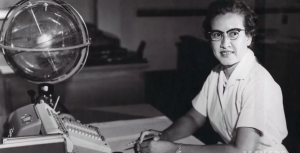
Katherine Johnson calculated trajectories for many of NASA’s space flights. Image from http://www.makers.com.
Katherine Johnson was born in 1918 in West Virginia. She loved mathematics as a child, and her family moved 125 miles so that she could attend school. She graduated from high school at the age of 14, and a year later enrolled at West Virginia State University. At 18, she graduated with a Bachelor’s degree in French and mathematics. She was one of the first African-Americans to enroll in the university’s graduate mathematics program, but family issues kept her from completing her degree and led to her early career as a math teacher.
In the early 1950s, Katherine became one of the female “computers” for NASA, working in the Guidance and Navigation Department. Katherine described her experience in an oral history for the National Visionary Leadership Project:
At first she worked in a pool of women performing math calculations. Katherine has referred to the women in the pool as virtual `computers who wore skirts.’ Their main job was to read the data from the black boxes of planes and carry out other precise mathematical tasks. Then one day, Katherine (and a colleague) were temporarily assigned to help the all-male flight research team. Katherine’s knowledge of analytic geometry helped make quick allies of male bosses and colleagues to the extent that, ‘they forgot to return me to the pool.’ While the racial and gender barriers were always there, Katherine says she ignored them. Katherine was assertive, asking to be included in editorial meetings (where no women had gone before.) She simply told people she had done the work and that she belonged.
Until her retirement in 1983, Katherine worked as an aerospace technologist. She calculated the trajectories for space flight, notably for Alan Shepard (the first American in space) in 1959. She was also asked to verify the numbers that computers calculated for orbits around the earth, and her reputation for accuracy helped establish NASA’s confidence in computerized trajectories. She also worked on the Apollo 11 and Apollo 13 missions, Space Shuttle missions, the Earth Resources satellite, and plans for a mission to Mars!
